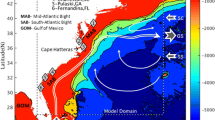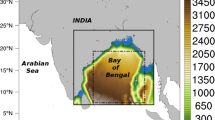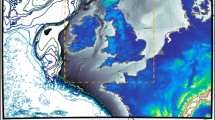Abstract
The coupled ocean–atmosphere–wave–sediment transport (COAWST) model is used to hindcast Hurricane Ivan (2004), an extremely intense tropical cyclone (TC) translating through the Gulf of Mexico. Sensitivity experiments with increasing complexity in ocean–atmosphere–wave coupled exchange processes are performed to assess the impacts of coupling on the predictions of the atmosphere, ocean, and wave environments during the occurrence of a TC. Modest improvement in track but significant improvement in intensity are found when using the fully atmosphere–ocean-wave coupled configuration versus uncoupled (e.g., standalone atmosphere, ocean, or wave) model simulations. Surface wave fields generated in the fully coupled configuration also demonstrates good agreement with in situ buoy measurements. Coupled and uncoupled model-simulated sea surface temperature (SST) fields are compared with both in situ and remote observations. Detailed heat budget analysis reveals that the mixed layer temperature cooling in the deep ocean (on the shelf) is caused primarily by advection (equally by advection and diffusion).











Similar content being viewed by others
References
Bao JW, Wilczak JM, Choi JK (2000) Numerical simulations of air-sea interaction under high wind conditions using a coupled model: a study of hurricane development. Mon Weather Rev 128:2190–2210. doi:10.1175/1520-0493(2000)128<2190:NSOASI>2.0.CO;2
Bao JW, Fairall CW, Michelson SA, Bianco L (2011) Parameterizations of sea-spray impact on the air–sea momentum and heat fluxes. Mon Weather Rev 139:3781–3797. doi:10.1175/MWR-D-11-00007.1
Bender MA, Ginis I, Tuleya R, Thomas B, Marchok T (2007) The operational GFDL coupled hurricane–ocean prediction system and a summary of its performance. Mon Weather Rev 135:3965–3989. doi:10.1175/2007MWR2032.1
Booij N, Ris RC, Holthuijsen LH (1999) A third-generation wave model for coastal regions. Part I: model description and validation. J Geophys Res 104:7649–7666. doi:10.1029/98JC02622
Charnock H (1955) Wind stress over a water surface. Q J Roy Meteorol Soc 81:639–640
Chassignet EP, Hurlburt HE, Smedstad OM, Halliwell GR, Hogan PJ, Wallcraft AJ, Baraille R, Bleck R (2006) The HYCOM (hybrid coordinate ocean model) data assimilative system. J Mar Syst 65:60–83. doi:10.1016/j.jmarsys.2005.09.016
Chen F, Dudhia J (2001) Coupling an advanced land-surface/ hydrology model with the Penn State/NCAR MM5 modeling system. Part I: model description and implementation. Mon Weather Rev 129:569–585. doi:10.1175/1520-0493(2001)129<0569:CAALSH>2.0.CO;2
Chen SYS, Price JF, Zhao W, Donelan MA, Walsh EJ (2007) The CBLAST-hurricane program and the next-generation fully coupled atmosphere-wave-ocean. models for hurricane research and prediction. Bull Am Meteorol Soc 88:311–317. doi:10.1175/BAMS-88-3-311
Chen SS, Zhao W, Donelan MA, Tolman HL (2013) Directional wind–wave coupling in fully coupled atmosphere–wave–ocean models: results from CBLAST-hurricane. J Atmos Sci 70:3198–3215. doi:10.1175/JAS-D-12-0157.1
Davis C, Wang W, Chen SS, Chen Y, Corbosiero K, DeMaria M, Dudhia J, Holland G, Klemp J, Michalakes J, Reeves H, Rotunno R, Snyder C, Xiao Q (2008) Prediction of landfalling hurricanes with the advanced Hurricane WRF model. Mon Weather Rev 136:1990–2005. doi:10.1175/2007MWR2085.1
Done J, Davis C, Weisman M (2004) The next generation of NWP: explicit forecasts of convection using the weather research and forecast (WRF) model. Atmos Sci Lett 5:110–117. doi:10.1002/asl.72
Donelan MA, Haus BK, Reul N, Plant WJ, Stiassnie M, Graber HC, Brown OB, Saltzman ES (2004) On the limiting aerodynamic roughness of the ocean in very strong winds. Geophys Res Lett 31, L18306. doi:10.1029/2004GL019460
Doyle JD (2002) Coupled atmosphere–ocean wave simulations under high-wind conditions. Mon Weather Rev 130:3087–3099. doi:10.1175/1520-0493(2002)130<3087:CAOWSU>2.0.CO;2
Drennan WM, Taylor PK, Yelland MJ (2005) Parameterizing the sea surface roughness. J Phys Oceanogr 35:835–848. doi:10.1175/JPO2704.1
Dudhia J (1989) Numerical study of convection observed during the winter monsoon experiment using a mesoscale two-dimensional model. J Atmos Sci 46:3077–3107. doi:10.1175/1520-0469(1989)046<3077:NSOCOD>2.0.CO;2
Fairall CW, Bradley EF, Rogers DP, Edson JB, Young GS (1996) Bulk parameterization of air-sea fluxes for tropical ocean-global atmosphere coupled-ocean atmosphere response experiment. J Geophys Res 101:3747–3764. doi:10.1029/95JC03205
Fairall CW, Bradley EF, Hare JE, Grachev AA (2003) Bulk parameterization of air-sea fluxes: updates and verification for the COARE algorithm. J Clim 16:571–591. doi:10.1175/1520-0442(2003)016<0571:BPOASF>2.0.CO;2
Fan Y, Ginis I, Hara T (2009) The effect of wind–wave–current interaction on air–sea momentum fluxes and ocean response in tropical cyclones. J Phys Oceanogr 39:1019–1034. doi:10.1175/2008JPO4066.1
Flather RA (1976) A tidal model of the northwest European continental shelf. Bull Soc Roy Sci Liege 6:141–164
Fowle MA, Roebber PJ (2003) Short-range (0–48 h) numerical prediction of convective occurrence, mode, and location. Wea Forecast 18:782–794. doi:10.1175/1520-0434(2003)018<0782:SHNPOC>2.0.CO;2
Garratt JR (1992) The atmospheric boundary layer. Cambridge University Press, Cambridge
Gemmill W, Katz B, Li X (2007) Daily real-time global sea surface temperature—high resolution analysis at NOAA/NCEP. NOAA/NWS/NCEP/MMAB Office Note 260
Goerss JS (2006) Prediction of tropical cyclone track forecast error for Hurricanes Katrina, Rita, and Wilma. Preprints, 27th Conf. on Hurricanes and Tropical Meteorology, Monterey, CA, Amer Meteor Soc 11A.1
Gopalakrishnan SG, Goldenberg S, Quirino T, Zhang X, Marks F Jr, Yeh KS, Atlas R, Tallapragada V (2012) Toward improving high-resolution numerical hurricane forecasting: influence of model horizontal grid resolution, initialization, and physics. Wea Forecast 27:647–666. doi:10.1175/WAF-D-11-00055.1
Haidvogel DB, Arango HG, Budgell WP, Cornuelle BD, Curchitser E, Di Lorenzo E, Fennel K, Geyer WR, Hermann AJ, Lanerolle L, Levin J, McWilliams JC, Miller AJ, Moore AM, Powell TM, Shchepetkin AF, Sherwood CR, Signell RP, Warner JC, Wilkin J (2008) Regional ocean forecasting in terrain-following coordinates: model formulation and skill assessment. J Comput Phys 227:3595–3624. doi:10.1016/j.jcp.2007.06.016
Halliwell GR Jr, Shay LK, Brewster JK, Teague WJ (2011) Evaluation and sensitivity analysis of an ocean model response to Hurricane Ivan. Mon Weather Rev 139:921–945. doi:10.1175/2010MWR3104.1
Hill KA, Lackmann GM (2009) Analysis of idealized tropical cyclone simulations using the weather research and forecasting model: sensitivity to turbulence parameterization and grid spacing. Mon Weather Rev 137:745–765. doi:10.1175/2008MWR2220.1
Hong SY, Lim JOJ (2006) The WRF single-moment 6-class microphysics scheme (WSM6). J Korean Meteor Soc 42:129–151
Hodur RM (1997) The naval research laboratory’s coupled ocean/atmosphere mesoscale prediction system (COAMPS). Mon Weather Rev 125:1414–1430. doi:10.1175/1520-0493(1997)125<1414:TNRLSC>2.0.CO;2
Hyun KH, He R (2010) Coastal upwelling in the South Atlantic bight: a revisit of the 2003 cold event using long term observations and model hindcast solutions. J Mar Syst 83:1–13. doi:10.1016/j.jmarsys.2010.05.014
Jacob R, Larson J, Ong E (2005) M x N communication and parallel interpolation in CCSM using the Model Coupling Toolkit. Preprints, Mathematics and Computer Science Division, Argonne National Laboratory, Argonne, IL
Jaimes B, Shay LK, Halliwell GR (2011) The response of quasigeostropic ocean vorticies to tropical cyclone forcing. Mon Weather Rev 41:1965–1985. doi:10.1175/JPO-D-11-06.1
Janjic ZI (1990) The step-mountain coordinate: physical package. Mon Weather Rev 118:1429–1443. doi:10.1175/1520-0493(1990)118<1429:TSMCPP>2.0.CO;2
Janjic ZI (1996) The surface layer in the NCEP Eta model. Extended abstracts, Eleventh Conference on Numerical Weather Prediction, Norfolk, VA, Amer Meteor Soc, 354–355
Janjic ZI (2002) Nonsingular implementation of the Mellor–Yamada Level 2.5 scheme in the NCEP Meso model. NCEP Office Note 437
Jones PW (1999) First- and second-order conservative remapping schemes for grids in spherical coordinates. Mon Weather Rev 127:2204–2210. doi:10.1175/1520-0493(1999)127<2204:FASOCR>2.0.CO;2
Kain JS (2004) The Kain–Fritsch convective parameterization: an update. J Appl Meteorol Climatol 43:170–181. doi:10.1175/1520-0450(2004)043<0170:TKCPAU>2.0.CO;2
Kirby JT, Chen TM (1989) Surface waves on vertically sheared flows: approximate dispersion relations. J Phys Oceanogr 94:1013–1027. doi:10.1029/JC094iC01p01013
Komen GJ, Hasselmann S, Hasselmann K (1984) On the existence of a fully developed wind-sea spectrum. J Phys Oceanogr 14:1271–1285. doi:10.1175/1520-0485(1984)014<1271:OTEOAF>2.0.CO;2
Kumar N, Voulgaris G, Warner JC, Olabarrieta M (2012) Implementation of the vortex force formalism in the coupled ocean–atmosphere–wave–sediment transport (COAWST) modeling system for inner shelf and surf zone applications. Ocean Model 47:65–95. doi:10.1016/j.ocemod.2012.01.003
Kurihara Y, Bender MA, Ross RJ (1993) An initialization scheme of hurricane models by vortex specification. Mon Weather Rev 121:2030–2045. doi:10.1175/1520-0493(1993)121<2030:AISOHM>2.0.CO;2
Kurihara Y, Bender MA, Tuleya RE, Ross RJ (1995) Improvements in the GFDL hurricane prediction system. Mon Weather Rev 123:2791–2801. doi:10.1175/1520-0493(1995)123<2791:IITGHP>2.0.CO;2
Larson J, Jacob R, Ong E (2004) The model coupling toolkit: a new Fortran90 toolkit for building multiphysics parallel coupled models. Preprints, Mathematics and Computer Science Division, Argonne National Laboratory, Argonne, IL
Lee C-Y, Chen SS (2014) Stable boundary layer and its impact on tropical cyclone structure in a coupled atmosphere–ocean model. Mon Weather Rev 142:1927–1944. doi:10.1175/MWR-D-13-00122.1
Lee C-Y, Chen SS (2012) Symmetric and asymmetric structures of hurricane boundary layer in coupled atmosphere–wave–ocean models and observations. J Atmos Sci 69:3576–3594. doi:10.1175/JAS-D-12-046.1
Leipper DF, Volgenau D (1972) Hurricane heat potential of the Gulf of Mexico. J Phys Oceanogr 2:218–224. doi:10.1175/1520-0485(1972)002<0218:HHPOTG>2.0.CO;2
Liu B, Liu H, Xie L, Guan C, Zhao D (2011) A coupled atmosphere–wave–ocean modeling system: simulation of the intensity of an idealized tropical cyclone. Mon Weather Rev 139:132–152. doi:10.1175/2010MWR3396.1
Liu L, Fei J, Cheng X, Huang X (2012) Effect of wind–current interaction on ocean response during Typhoon Kaemi (2006). Sci China Earth Sci 56:418–433. doi:10.1007/s11430-012-4548-3
Ma Z, Fei J, Liu L, Huang X, Cheng X (2013) Effects of the cold core eddy on tropical cyclone intensity and structure under idealized air–sea interaction conditions. Mon Weather Rev 141:1285–1303. doi:10.1175/MWR-D-12-00123.1
Madsen OS, Poon YK, Graber HC (1988) Spectral wave attenuation by bottom friction: theory. In: Proc 21th Int Conf Coastal Engineering, Torremolinos, Spain, Am Soc Civ Eng 492–504
Marks FD, Shay LK (1998) Landfalling tropical cyclones: forecast problems and associated research opportunities. Bull Am Meteorol Soc 79:305–323
Marchesiello P, McWilliams JC, Shchepetkin AF (2001) Open boundary conditions for long-term integration of regional oceanic models. Ocean Model 3:1–20. doi:10.1016/S1463-5003(00)00013-5
Mellor GL, Yamada T (1982) Development of a turbulence closure model for geophysical fluid problems. Rev Geophys Space Phys 20:851–875. doi:10.1029/RG020i004p00851
Mlawer EJ, Taubman SJ, Brown PD, Iacono MJ, Clough SA (1997) Radiative transfer for inhomogeneous atmosphere: RRTM, a validated correlated-k model for the longwave. J Geophys Res 102:16663–16682. doi:10.1029/97JD00237
Monin AS, Obukhov AM (1954) Basic laws of turbulent mixing in the surface layer of the atmosphere. Contrib Geophys Inst Acad Sci 151:163–187
Moon IJ, Ginis I, Hara T, Thomas B (2007) A physics-based parameterization of air–sea momentum flux at high wind speeds and its impact on hurricane intensity predictions. Mon Weather Rev 135:2869–2878. doi:10.1175/MWR3432.1
Nelson J, He R (2012) Effect of the Gulf stream on winter extratropical cyclone outbreaks. Atmos Sci Lett 13:311–316. doi:10.1002/asl.400
Oey LY, Ezer T, Wang DP, Yin XQ, Fan SJ (2006) Loop current warming by Hurricane Wilma. Geophys Res Lett 33, L08613. doi:10.1029/2006GL025873
Olabarrieta M, Warner JC, Kumar N (2011) Wave–current interaction in Willapa Bay. J Geophys Res 116, C12014. doi:10.1029/2011JC007387
Olabarrieta M, Warner JC, Armstrong B, He R, Zambon JB (2012) Ocean–atmosphere dynamics during Hurricane Ida and Nor’Ida: an application of the coupled ocean–atmosphere–wave–sediment transport (COAWST) modeling system. Ocean Model 43–44:112–137. doi:10.1029/2011JC007387
Oost WA, Komen GJ, Jacobs CMJ, van Oort C (2002) New evidence for a relation between wind stress and wave age from measurements during ASGAMAGE. Bound Layer Meteor 103:409–438
Prasad TG, Hogan PJ (2007) Upper-ocean response to Hurricane Ivan in a 1/25° nested Gulf of Mexico HYCOM. J Geophys Res 112, C04013. doi:10.1029/2006JC003695
Price JF (1981) Upper ocean response to a hurricane. J Phys Oceanogr 11:153–175. doi:10.1175/1520-0485(1981)011<0153:UORTAH>2.0.CO;2
Price JF, Sanford TB, Forristall GZ (1994) Forced stage response to a moving hurricane. J Phys Oceanogr 24:233–260. doi:10.1175/1520-0485(1994)024<0233:FSRTAM>2.0.CO;2
Pollard RT, Rhines PB, Thompson RORY (1973) The deepening of the wind-mixed layer. Geophys Astrophys Fluid Dyn 3:381–404. doi:10.1080/03091927208236105
Powell MD, Houston SH, Amat LR, Morisseau-Leroy N (1998) The HRD real-time hurricane wind analysis system. J Wind Eng Ind Aerodyn 77–78:53–64. doi:10.1016/S0167-6105(98)00131-7
Rogers R, Aberson S, Black M, Black P, Cione J, Dodge P, Gamache J, Kaplan J, Powell M, Dunion J, Uhlhorn E, Shay N, Surgi N (2006) The intensity forecasting experiment: a NOAA multiyear field program for improving tropical cyclone intensity forecasts. Bull Am Meteorol Soc 87:1523–1537. doi:10.1175/BAMS-87-11-1523
Shay LK, Ali MM, Barbary D, D’Asaro EA, Halliwell G, Doyle J, Fairall C, Ginis I, Lin II, Moon IJ, Sandery P, Uhlhorn E, Wada A (2010) Air–sea interface and oceanic influences. In: 7th WMO International Workshop on Tropical Cyclones (IWTC-VII), St. Gilles Les Bains, La Réunion, France, World Meteor Org. http://www.wmo.int/pages/prog/arep/wwrp/tmr/otherfileformats/documents/1_3.pdf. Accessed 29 August 2013
Shchepetkin AF, McWilliams JC (2005) The regional ocean modeling system: a split-explicit, free-surface, topography-following coordinates ocean model. Ocean Model 9:347–404. doi:10.1016/j.ocemod.2004.08.002
Skamarock WC, Klemp JB, Dudhia J, Gill DO, Barker DM, Wang W, Powers JG (2005) A description of the advanced research WRF version 2. NCAR Technical Note
Stewart S (2005) Tropical cyclone report: Hurricane Ivan 2–24 September 2004. National Hurricane Center. http://www.nhc.noaa.gov/2004ivan.shtml. Accessed 17 June 2013
Taylor PK, Yelland MJ (2001) The dependence of sea surface roughness on the height and steepness of the waves. J Phys Oceanogr 31:572–590. doi:10.1175/1520-0485(2001)031<0572:TDOSSR>2.0.CO;2
Teague WJ, Jarosz E, Wang DW, Mitchell DA (2007) Observed oceanic response over the upper continental slope and outer shelf during Hurricane Ivan. J Phys Oceanogr 37:2181–2206. doi:10.1175/JPO3115.1
Wada A, Cronin MF, Sutton AJ et al (2013a) Numerical simulations of oceanic pCO2 variations and interactions between Typhoon Choi‐wan (0914) and the ocean. J Geophys Res Oceans 118:2667–2684. doi:10.1002/jgrc.20203
Wada A, Kohno N, Kawai Y (2010) Impact of wave–ocean interaction on Typhoon Hai-Tang in 2005. SOLA 6A:13–16. doi:10.2151/sola.6A-004
Wada A, Uehara T, Ishizaki S (2014) Typhoon-induced sea surface cooling during the 2011 and 2012 typhoon seasons: observational evidence and numerical investigations of the sea surface cooling effect using typhoon simulations. Prog Earth Planet Sci 64:3562–3578. doi:10.1175/JAS4051.1
Wada A, Usui N, Kunii M (2013b) Interactions between typhoon Choi-wan (2009) and the Kuroshio extension system. Adv Meteorol 2013:1–17. doi:10.5670/oceanog.2011.91
Wang Y, Wu CC (2004) Current understanding of tropical cyclone structure and intensity changes—a review. Meteorol Atmos Phys 87:257–278. doi:10.1007/s00703-003-0055-6
Walker ND, Leben RR, Balasubramanian S (2005) Hurricane-forced upwelling and chlorophyll a enhancement within cold-core cyclones in the Gulf of Mexico. Geophys Res Lett 32, L18610. doi:10.1029/2005GL023716
Warner JC, Perlin N, Skyllingstad E (2008) Using the model coupling toolkit to couple earth system models. Environ Model Softw 23:1240–1249
Warner JC, Armstrong B, He R, Zambon JB (2010) Development of a coupled ocean–atmosphere–wave–sediment transport (COAWST) modeling system. Ocean Model 35:230–244. doi:10.1016/j.oceanmod.2010.07.010
Wu CC, Lee CY, Lin II (2007) The effect of the ocean eddy on tropical cyclone intensity. J Atmos Sci 64:3562–3578. doi:10.1175/JAS4051.1
Yablonsky RM, Ginis I (2009) Limitation of one-dimensional ocean models for coupled hurricane–ocean model forecasts. Mon Weather Rev 137:4410–4419. doi:10.1175/2009MWR2863.1
Yablonsky RM, Ginis I (2013) Impact of a warm ocean eddy’s circulation on hurricane-induced sea surface cooling with implications for hurricane intensity. Mon Weather Rev 141:997–1021. doi:10.1175/MWR-D-12-00248.1
Acknowledgments
Research support provided by USGS Coastal Process Project, Gulf of Mexico Research Initiative/GISR through grant 02-S130202, NOAA grant NA11NOS0120033, NASA grants NNX12AP84G, and NNX13AD80G is much appreciated. We acknowledge the National Hurricane Center for making hurricane best-track data available online.
Author information
Authors and Affiliations
Corresponding author
Additional information
Responsible Editor: Aida Alvera-Azcárate
Rights and permissions
About this article
Cite this article
Zambon, J.B., He, R. & Warner, J.C. Investigation of hurricane Ivan using the coupled ocean–atmosphere–wave–sediment transport (COAWST) model. Ocean Dynamics 64, 1535–1554 (2014). https://doi.org/10.1007/s10236-014-0777-7
Received:
Accepted:
Published:
Issue Date:
DOI: https://doi.org/10.1007/s10236-014-0777-7




